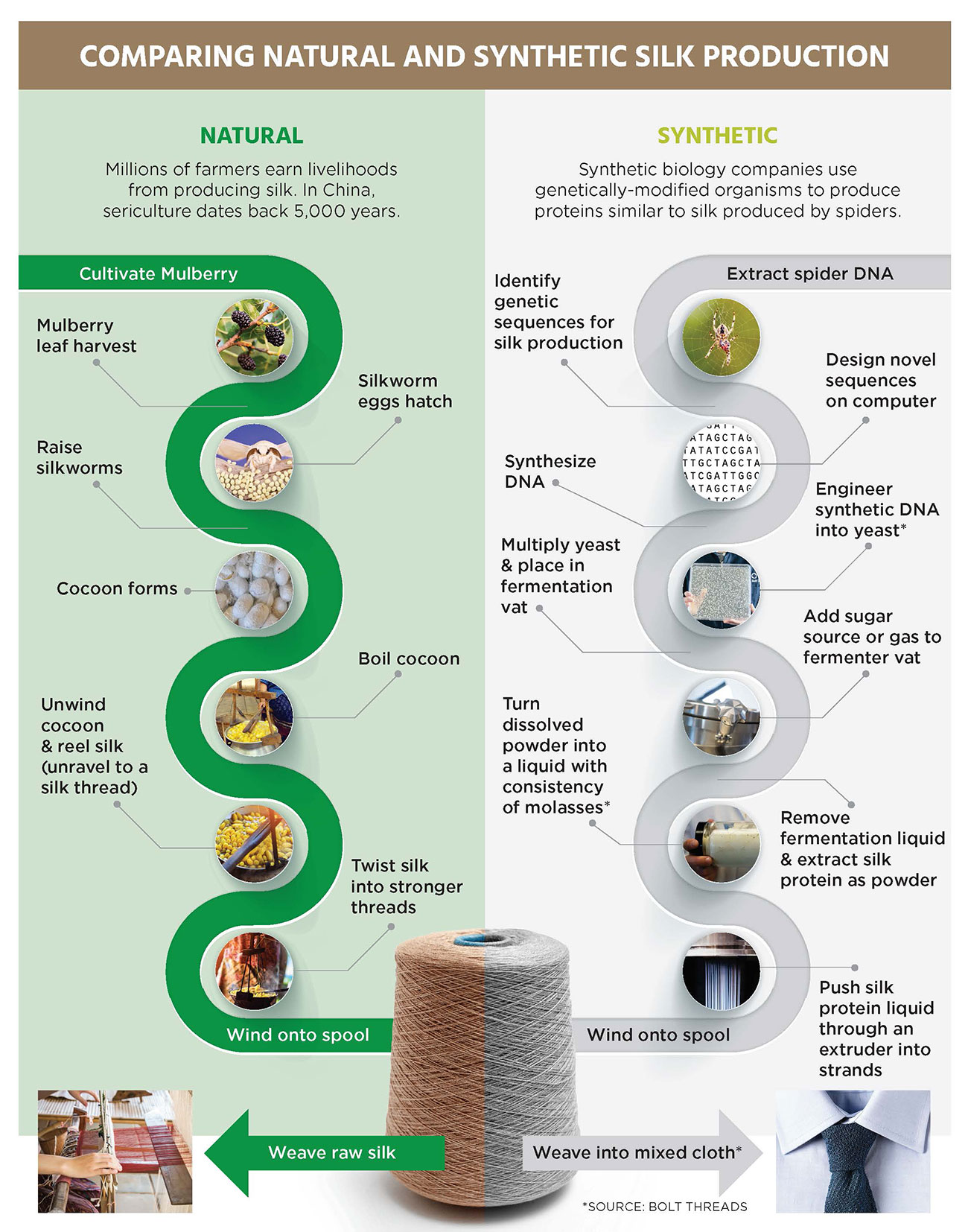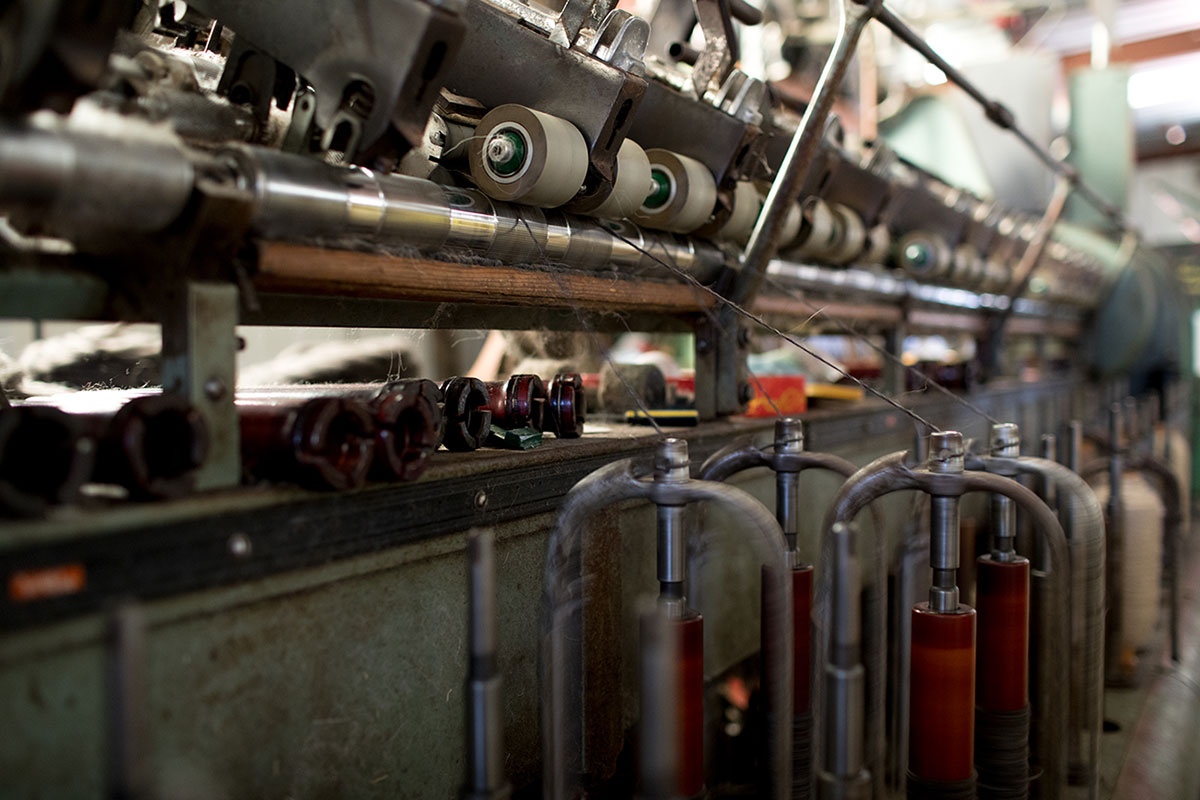Written by Rebecca Burgess and Jess Daniels
Fibershed is honored to be featured in an important and newly published report: The Nature of Fashion: Moving towards a regenerative system by our colleagues and collaborators at the Biomimicry Institute. The paper is a refreshing analysis of the textile industry via the lens of natural cycles and defines and amplifies the work to physically manifest a model of textile production that: “boosts biodiversity, builds soil, supports communities, and cleans up existing pollution.”

The paper highlights nature’s dynamic equilibrium and points to a broken link between primary production and decomposition. This disconnect has and continues to generate textile-based pollution, and the report shows how both virgin and recycled plastic sources of pollution disperse into earth’s biome. The paper challenges the industry to design for the reality of earth’s dispersal processes, including a focus on decentralizing and co-locating textile production and decomposition systems. The writers lay out a suite of options, including regenerative agriculture—with a focus on integrated agricultural systems and decentralized, regional production as key solutions.
“Whether natural or synthetic, carbon-based or metallic, industrial resource loops exist inside biological ones, not side-by-side. The outermost loop is always the biosphere: air, water, and soil.” – The Nature of Fashion p. 10
Currently, plastic fibers are positioned as the first choice in sustainability by many of the leading frameworks promoted by and for the textile industry. The Nature of Fashion logically upends this approach by embedding circularity within the earth’s natural cycles and systems.
This upending has been a long time coming. For years, many organizations (including our own) have spoken to the dire issues of plastic fiber contamination that now exist in drinking water, high elevation snow packs, animal bodies, soils, and marine ecosystems. Yet, we continue to see brands, including those most praised and publicly regarded for their environmental consciousness, use plastic fibers in their clothing lines.
The Nature of Fashion presents a solid and resolute message for the need to phase out the use of plastic in our textile systems:
“Since so-called “infinitely recyclable” synthetic polymers last for only 10 or so cycles (and most plastics for only two to three cycles), even a long-lasting synthetic polymer must be designed to return safely to the soil, either slowly, like wood, or in response to a chemical switch, like bone… This means there is no alternative to the phasing out of non-compostable materials like polyester, and new fibers, however “recyclable” should not be developed if there is no natural decomposition for them…. we see that the laws of physics ensure polyester, even when recycled, will ultimately be a pollutant.” – p. 9-11
We are very pleased and supportive of this statement and look forward to working with the Biomimicry Institute to make this phase-out a material reality.

Unfortunately, The Nature of Fashion’s bold and necessary lens for holistic material analysis is not fully applied to the proposed vision for increasing fiber production through the expansion of “biosynthetics” via fermentation of microorganisms, including genetically engineered microorganisms. By putting forward this technology as a solution, the report obscures the ability to fully envision and execute a fashion industry that aligns with biological principles and the laws of physics.
Fibershed disagrees with the report’s characterization of fiber production via fermentation as a process that “is clean and well suited to bioregional production.” (p. 17).
There is currently an abundant supply of natural fiber being produced directly on the landscape, and in many bioregions, this fiber is underutilized. The circular framework outlined in The Nature of Fashion encourages us to look at all inputs, outputs, and decomposition pathways for a material. Simply put, synthetic biology fibers do not align with the principles of a future where “all fashion industry loops (technical and biological) could cross and mingle.”
Further, while polyester accounts for the majority of global fiber production, we know that overproduction in the fashion industry is a huge problem, leading to dumping and incinerating excess inventory on an alarmingly regular basis. Researchers have recently suggested that bringing fashion to earth-supporting levels means decreasing consumption by 50% and doubling the lifespan of clothing.
Innovation and technology are key to developing thriving bioregional fiber economies, however, when we look at the application of biotechnology to fiber production, we see impacts that outweigh the intent.

Through the biosphere-based lens of The Nature of Fashion, we consider the following concerns for fibers created with synthetic biology and patented gene-editing techniques:
Inputs:
- The report acknowledges that “the feedstock for fermented fibers is not yet a clear sustainability advantage. ‘We have to remember that fermentation is tied to carbon, which currently comes from sugar,’ says Natsai Audrey Chieza, founder and director of Faber Futures.”
- Bacteria that are genetically engineered to make fiber and dye materials are currently powered by sugars sourced from sugar cane, genetically engineered corn, or genetically engineered sugar beets. Contrary to the marketing claims, these “lab-based” fiber and dyes are inextricably tied to highly problematic cropping systems associated with poor labor conditions, eutrophication of fresh and saltwater ecosystems, as well as land-grabs that threaten the livelihoods of small scale and indigenous farmers across the globe.
- As reported in Genetically Engineered Clothes: Synthetic Biology’s New Spin on Fast Fashion, engineers working on synthetic biology continue to claim that they will be able to engineer their way out of their reliance on sugar feedstocks, but that has not been shown in the material sector or in the decades-long projects to develop fuel algae produced by genetically engineered bacteria.
- Land used to grow feedstocks to feed microbes must be questioned in an era requiring a focus on human health and caloric needs. Scaling microbe-filled fermentation tank technologies may appear to be a more benign version of a contained animal feeding operation, however, this design (with its reliance on human food-based feedstocks) carries similar environmental complexities and costs associated with the containment of any living organism.
Decomposition:
- We agree with the report’s principle that “we must not use fermentation to produce non-biodegradable fibers” (p. 18)
- Unfortunately, an existing example of this type of fiber produced at market scale is called Sorona, a biosynthetic material made not by a bioregional economy but by industrial plastics and chemicals company DuPont. Though marketed as “bio-based,” this fiber, in fact, relies on blending the fermentation by-product with virgin plastics. Sorona actually contains primarily petroleum-derived fiber — approximately 37% of the yarn is Bio-PDO — and it is not biodegradable.
- Bolt threads “Microsilk™” is another prominent fiber created with this technology — imitating the proteins created by spiders using genetically engineered yeast, it has netted hundreds of millions of dollars of investment capital yet still only holds an unproven “potential to biodegrade.”
- Even biosynthetic fibers that are expected or intended to be biodegradable have not been well studied to understand their breakdown products and the potential impacts those products could have on natural ecosystems. Bio-plastics like cutlery labeled as compostable have risen quickly to replace disposable items in many communities, yet waste haulers and compost experts have been calling out the functional challenges in achieving biodegradation results, even in ideal conditions like hot compost piles.
Outputs:
- As the authors write: “it is important to keep in mind the certainty that materials produced using this method will escape into the environment” (p. 17), and in the ensuing footnote, the genetically modified bacteria and yeast are described as “harmless and usually highly attenuated, meaning they cannot survive outside the highly calibrated and supportive environment of the facility” (p. 18)
- This is contrasted by expert findings on the risk of contamination, as covered in the GE Clothes report: “Containment of organisms developed with synthetic biology is not practical or possible. Experts conclude that physical containment of synthetic organisms is not practical, especially within large-scale production systems. A US Presidential Commission acknowledged in 2010 that ‘contamination by accidental or intentional release of organisms developed with synthetic biology is among the principal anticipated risks.’”
- Again the Sorona fiber by DuPont provides a clear case study. As written in the GE Clothes report: “the fermentation process that produces DuPont’s Sorona bio-ingredient creates not only CO2 but also waste – currently about 12,000 tons of “spent microbial biomass” (SMB) annually from its Tennessee production facility, which is shipped to landfills for disposal. In conventional fermentation-based industries such as beer-making, SMB is used in agricultural production as feed or fertilizer. Because DuPont’s microbes have been extensively genetically engineered, its SMB hasn’t been used in agriculture ‘due to concerns over horizontal gene transfer.’” (p. 5, quoting Sullivan et al. 2017, Utilization of Spent Microbial Biomass as an Alternative Crop Nitrogen Source)
While there are many unknowns regarding the impacts and true circularity of biosynthetic fibers, one thing is certain: risk assessment must be rooted in precaution for and participation of impacted communities. The price point and engineered characteristics of biosynthetic fibers aim to directly compete with natural fibers, including silk, wool, and cotton, which threatens rural communities where fiber production economies already hang by a thread.
It is not the quality of the product or the dedication and skill of the people who produce fiber that has undermined natural fiber production. It is race-to-the-bottom economics that has pushed the limits of certain land bases (such as Cashmere production in Mongolia), squeezed workers across the supply web into unjust conditions, and nearly erased the genetic diversity of naturally colored cotton and wool. Together we need to address and re-engineer this extractive system, rather than striving for a silver bullet of genetically modified life forms just to keep the fashion economy churning.
The biotechnology vision of fiber production centers on “biorefineries” in urban centers for a sort of post-industrial “revitalization.” Here, we cannot ignore the history of material refineries in targeted communities. Dr. Robert Bullard, known as “the father of environmental justice,” has generated decades of scholarship and advocacy on the history and disparities of race and industrial pollution and the harmful impacts on the soil, air, and water of surrounding areas, as well as worker health.

Decentralization is not limited to a conversation of machinery or fermentation tanks—decentralization in the textile industry must include conversations of wealth and power, especially considering the industry’s history of forced and enslaved labor and land theft. Patents that are developed to privatize genetic life have been allowed in the United States since 1980 and further promote wealth to concentrate into fewer hands while driving investments away from open source and appropriate technologies that would empower a diverse strata of community members to benefit and gain very needed social and economic mobility within textile production systems.
The Nature of Fashion rightly points out that the fashion industry’s current clamoring for circularity needs to be readjusted and rooted within the earth’s bounds. The report highlights “levers for change” beginning with a directive to “invest in local cycles” and “build restorative and regenerative agriculture systems.” These two levers alone hold abundant potential and highlight tremendous, tangible need (such as fiber milling equipment, soil conservation funding streams, and natural fiber recycling capacity). Unfortunately, “Lever 3: Incentivize creation of new biomaterials” is largely incompatible with the report’s vision for regional, biodegradable, and community-supporting fashion systems.
We encourage readers to learn from The Nature of Fashion and the “dynamic equilibrium” that is explored and applied to the current fashion system. With shared goals of “moving towards a regenerative system,” we are grateful for the opportunity to have Fibershed’s work and principles featured in the report, and we look forward to collaborating with communities around the world in support of place-based fiber economies supported by appropriate technology and carbon farming.
